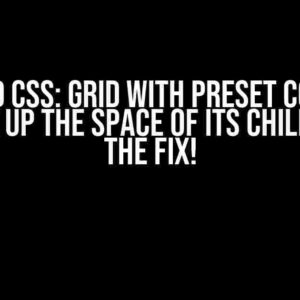We’ve all been there – you’re building a beautiful website, adding elements left and right, and suddenly, BAM! Your innerHTML decides to take a walk outside its container. It’s frustrating, it’s annoying, and it’s a real pain to deal with. But fear not, dear developer, for today, we’re going to tackle this issue head-on and explore the ways to prevent it from happening in the first place.
Understanding the Problem
Before we dive into the solutions, let’s take a step back and understand why this issue occurs in the first place. When you add elements to a container using innerHTML, the browser will render those elements according to the container’s CSS styles. However, if the container’s styles are not set correctly, or if the elements being added are too large, they can overflow outside the container.
There are several reasons why this might happen:
- Insufficient container size: If the container’s width or height is too small, the added elements will overflow outside it.
- Poor CSS styling: If the container’s CSS styles are not set correctly, the elements may not be contained within it.
- Large element size: If the elements being added are too large, they can overflow outside the container.
- Nested elements: If you have nested elements with incorrect styling, it can cause the innerHTML to overflow outside the container.
Solutions to Prevent innerHTML from Going Out of Container
Now that we’ve identified the possible causes, let’s explore the solutions to prevent innerHTML from going out of container:
1. Set a fixed container size
One of the simplest ways to prevent innerHTML from overflowing is to set a fixed size for the container. You can do this by adding a width and height property to the container’s CSS styles.
<div id="container" style="width: 500px; height: 300px; overflow: hidden;"> <!-- add elements here --> </div>
In this example, we’ve set the container’s width to 500px and height to 300px. We’ve also added the `overflow: hidden` property to ensure that any excess content is hidden from view.
2. Use CSS Flexbox
CSS Flexbox is a powerful layout mode that can help contain innerHTML within a container. You can use Flexbox to create a flexible container that adapts to the size of its contents.
<div id="container" style="display: flex; flex-wrap: wrap;"> <!-- add elements here --> </div>
In this example, we’ve set the container’s display property to `flex` and added the `flex-wrap: wrap` property to ensure that the elements wrap to the next line when the container’s width is reached.
3. Use CSS Grid
CSS Grid is another powerful layout mode that can help contain innerHTML within a container. You can use Grid to create a grid-based layout that adapts to the size of its contents.
<div id="container" style="display: grid; grid-template-columns: repeat(3, 1fr);"> <!-- add elements here --> </div>
In this example, we’ve set the container’s display property to `grid` and added the `grid-template-columns` property to create a grid with three columns.
4. Use overflow: auto
The `overflow: auto` property is a simple yet effective way to prevent innerHTML from overflowing outside the container. This property adds a scrollbar to the container when the content exceeds its size.
<div id="container" style="overflow: auto;"> <!-- add elements here --> </div>
5. Use a wrapper element
Sometimes, you may need to contain innerHTML within a specific area of the container. In such cases, you can use a wrapper element to wrap around the innerHTML and set its styles accordingly.
<div id="container">
<div id="wrapper" style="max-width: 500px; overflow: hidden;">
<!-- add elements here -->
</div>
</div>
In this example, we’ve added a wrapper element with a maximum width of 500px and set its overflow property to `hidden`. This will ensure that the innerHTML is contained within the wrapper element.
Best Practices to Prevent innerHTML from Going Out of Container
In addition to the solutions mentioned above, here are some best practices to prevent innerHTML from going out of container:
- Set a clear goal for your container’s size: Before adding elements to your container, decide on a clear size goal for it. This will help you set the correct CSS styles and ensure that the container adapts to its contents.
- Use a consistent styling approach: Use a consistent styling approach throughout your project to ensure that your containers and elements have a uniform size and layout.
- Test and iterate: Test your container and elements regularly to ensure that they are not overflowing outside the container. Iterate on your design and styling until you achieve the desired result.
- Use the browser’s dev tools: Use the browser’s dev tools to inspect your container and elements. This will help you identify any styling issues and make necessary adjustments.
- Keep it simple: Avoid complex nesting and styling that can cause innerHTML to overflow outside the container. Keep your design and styling simple and easy to manage.
Conclusion
In conclusion, preventing innerHTML from going out of container is a matter of using the right CSS styles and techniques. By setting a fixed container size, using CSS Flexbox or Grid, adding a wrapper element, and following best practices, you can ensure that your innerHTML stays within its container.
Remember, the key to preventing innerHTML from overflowing is to test and iterate regularly. With practice and patience, you can master the art of containing innerHTML and create beautiful, functional websites that impress your users.
| Solution | Description |
|---|---|
| Fixed container size | Set a fixed width and height for the container to prevent innerHTML from overflowing. |
| CSS Flexbox | Use CSS Flexbox to create a flexible container that adapts to the size of its contents. |
| CSS Grid | Use CSS Grid to create a grid-based layout that adapts to the size of its contents. |
| overflow: auto | Add a scrollbar to the container when the content exceeds its size. |
| Wrapper element | Use a wrapper element to wrap around the innerHTML and set its styles accordingly. |
By following these solutions and best practices, you can ensure that your innerHTML stays within its container and create a beautiful, functional website that impresses your users.
Here are 5 Questions and Answers about “My elements (innerHTML) goes out of Container. How to prevent it?”
Frequently Asked Question
Get the solutions to the most common issue in HTML development where your elements’ innerHTML goes out of the container and ruins your layout!
Why does my innerHTML go out of the container in the first place?
Well, buddy, it’s because the default behavior of HTML elements is to take up only the necessary space to display their content. So, when your innerHTML exceeds that space, it will overflow and make a mess of your layout! To prevent this, you need to set a maximum width or height for your container, or use CSS properties like overflow:hidden or overflow:auto to keep everything in check.
How do I set a maximum width or height for my container?
Easy peasy! You can use CSS to set a maximum width or height for your container by adding the max-width or max-height property to your container’s CSS rules. For example: container { max-width: 800px; } or container { max-height: 600px; }. You can also use the width and height properties to set a fixed size for your container.
What’s the difference between overflow:hidden and overflow:auto?
overflow:hidden will simply clip off any excess content that goes beyond the container’s boundaries, while overflow:auto will add a scrollbar to your container so that users can scroll through the excess content. So, choose wisely depending on your layout requirements!
Can I use flexbox or grid to prevent innerHTML from overflowing?
Yes, you can! Flexbox and grid are both powerful layout modes that allow you to control the size and arrangement of your container’s children. By using flexbox or grid, you can set up your container to automatically adjust its size based on its content, preventing overflow issues. For example, you can use display:flex; and flex-wrap:wrap; to create a flexible container that wraps its content into multiple lines.
Are there any other tricks to prevent innerHTML from overflowing?
One more trick up the sleeve! You can use the word-wrap or white-space properties to control how text content is wrapped within your container. For example, word-wrap:break-word; will break long words into multiple lines, while white-space:normal; will collapse multiple white spaces into a single space. These properties can be super helpful in preventing overflow issues.



